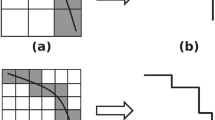Abstract
In this paper, a novel face recognition method, named as wavelet-curvelet-fractal technique, is proposed. Based on the similarities embedded in the images, we propose to utilize the wavelet-curvelet-fractal technique to extract facial features. Thus we have the wavelet’s details in diagonal, vertical, and horizontal directions, and the eight curvelet details at different angles. Then we adopt the Euclidean minimum distance classifier to recognize different faces. Extensive comparison tests on different data sets are carried out, and higher recognition rate is obtained by the proposed technique.
Similar content being viewed by others
References
Min Yoon, Yeboon Yun, and H. Nakayama. A role of total margin in support vector machines. Proceedings of the International Joint Conference on Neural Networks, Oregon, US, 2003, Vol.3, 2049–2053.
M. Joo. Face recognition with radial basis function (RBF) neural networks. IEEE Transactions on Neural Networks, 13(2002)3, 697–710.
H. J. Kim. Face recognition using kernel principal component analysis. IEEE Transactions on Signal Processing Letters, 9(2002)2, 40–42.
R. Chellappa. Human and machine recognition of faces: a survey. IEEE Transactions on Signal Processing, 83(1995)5, 705–740.
F. Luthon. Nonlinear color space and spatiotemporal MRF for hierarchical segmentation of face features in video. IEEE Transactions on Image Processing, 13(2004)1, 63–71.
J. G. Wang and E. Sung. Facial feature extraction in an infrared image by proxy with a visible face image. IEEE Transactions on Instrumentation and Measurement, 56(2007)5, 2057–2066.
W. Zhao, R. Chellappa, et al. Face recognition: A literature survey. ACM Computing Surveys, 35(2003) 4, 399–458.
A. Martinez. Recognizing imprecisely localized, partially occluded and expression variant faces from a single sample per class. IEEE Transactions on Pattern Analysis and Machine Intelligence, 24(2002)6, 748–763.
M. H. Yang, D. Kriegman, and N. Ahuja. Detecting faces in images: A survey. IEEE Transactions on Pattern Analysis and Machine Intelligence, 24(2002)1, 34–58.
T. Cootes, C. Taylor, D. Cooper, and J. Graham. Active shape models — their training and application. Computer Vision Image Understand, 61(1995)1, 18–23.
T. Cootes, G. J. Edwards, and C. Taylor. Active appearance models. IEEE Transactions on Pattern Analysis and Machine Intelligence, 23(2001)6, 681–685.
R. M. Rao and A. S. Bopardikar. Wavelet Transforms-Introduction to Theory and Applications. Addison Wesley Longman, 1998.
C. Garcia, G. Zikos, and G. Tziritas. A Wavelet-based framework for face recognition. Workshop on Advances in Facial Image Analysis and Recognition Technology, 5th European Conference on Computer Vision, Freiburg, Germany, 1998, 84–92.
L. Huang. Face recognition using total margin-based adaptive fuzzy support vector machines. IEEE Transactions on Neural Networks, 18(2007)1, 178–192.
Y. S. Gao. Face recognition using line edge map. IEEE Transactions on Pattern Analysis and Machine Intelligence, 24(2002)6, 764–778.
S. Mitra, M. Savvides, and B. V. K. Kumar. Face identification using novel frequency-domain representation of facial asymmetry. IEEE Transactions on Information Forensics and Security, 1(2006)3, 350–358.
Y. X. Liu. Image feature extraction and segmentation using fractal dimension. ICICS’97, Singapore, 1997, 975–979.
P. Zhang, T. D. Bui, and C. Y. Suen. Recognition of similar objects using 2-D wavelet-fractal feature extraction. Proceedings of ICPR, Quebec city, Canada, 2002, 316–319.
T. Mandal. A new approach to face recognition using curvelet transform. [Master Dissertation], University of Windsor, 2008, 82–83.
J. Chien. Discriminant waveletfaces and nearest feature classifiers for face recognition. IEEE Transactions on Pattern Analysis and Machine Intelligence, 24(2002)12, 1644–1649.
Author information
Authors and Affiliations
Corresponding author
Additional information
Supported by the College of Heilongjiang Province, Electronic Engineering Key Lab Project dzzd200602 and Heilongjiang Province Educational Bureau Scientific Technology Important Project 11531z18.
Communication author: Zhang Zhong, born in 1972, male, Ph.D., Professor.
About this article
Cite this article
Zhang, Z., Zhuang, P., Liu, Y. et al. Face recognition based on wavelet-curvelet-fractal technique. J. Electron.(China) 27, 206–211 (2010). https://doi.org/10.1007/s11767-010-0310-6
Received:
Revised:
Published:
Issue Date:
DOI: https://doi.org/10.1007/s11767-010-0310-6




